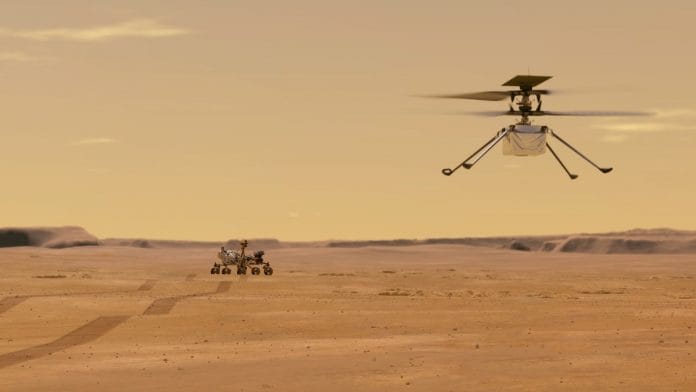Chennai: NASA’s most ambitious and expensive mission to the Red Planet, Mars 2020, is scheduled to touch down on its surface Friday (IST).
The mission carries the sophisticated fossil-hunting rover Perseverance, and the Ingenuity Mars Helicopter, the first chopper to fly on another planet.
Its mission — astrobiological in nature — includes assessing the planet’s habitability and looking for evidence of past or present life by studying biosignatures in the Jezero crater, an ancient lakebed that is believed to have once been filled with liquid water when conditions were more hospitable.
The landing process will start at 8.38pm GMT (02.08 am IST on 19 February), when the heat shield capsule housing the spacecraft will enter the atmosphere, and end at 8.55 pm GMT (02.25 am IST) when the rover touches down.
Also read: Mars, Moon & a fresh pair of eyes in the sky — the big space missions planned for 2021
Landing
The mission’s landing will mimic the “seven minutes of terror” — a name given to the complicated sequence of manoeuvres needed to land on Mars — that the Curiosity lander underwent as it touched down on the Red Planet in 2012.
However, instead of the balloon cocoon that Curiosity bounced around in, Perseverance will make a powered descent with the help of a landing system with a sky crane. This will be preceded by a heat-shield entry and a supersonic parachute, which will release the sky crane attached to the rover.
The design of Perseverance is borrowed heavily from Curiosity’s as well. The rover is 3m long, 2.7m wide, and 2.2m tall — similar to Curiosity — and weighs 1,025 kg on Earth (Curiosity was 899 kg), making it 393 kg on Mars thanks to the weaker gravity on Mars.
There is a notable addition in the form of a microphone on the side of the rover, which will be the first to capture the sounds of landing on Mars. It will also be the first mission to capture and send sounds to Earth from another planet. Two other microphones have been flown to Mars before, one crashed during landing, and another was never turned on because of a flaw being discovered in the instrument before launch.
During landing, Perseverance won’t be directly in the Earth’s line of sight, and landing confirmation will be sent by NASA’s Mars Reconnaissance Orbiter (MRO), which will be flying overhead at the time. NASA’s MAVEN orbiter will also transmit data 10 hours later.
Perseverance will perform a series of instrument deployments and initial movement tests for the first 30 Martian days, known as sols. The duration of one sol is 24 hours, 39 minutes, 35.24 seconds. After 30 sols, Perseverance will drive to a flying site and release the Ingenuity helicopter.
It will drive 100m away from the helicopter, after which a test flight will be attempted.
Also Read: What a simulated Mars mission taught me about food waste
Scientific objectives
The Perseverance rover’s objective is to study and understand the geology of Mars, and look for evidence of past microbial life on the planet. It will do so by collecting and storing soil and rock samples for a future sample-return mission, while also analysing samples in-situ.
It carries seven science payloads. Two of these are sophisticated camera systems. The Mastcam-Z has panoramic and stereoscopic imaging ability, as well as zoom, and can perform mineral analysis on soil. The SuperCam can take pictures and perform chemical composition analysis on rock samples. It also carries a microphone.
There are two spectrometers on board. The Planetary Instrument for X-ray Lithochemistry (PIXL) will perform element composition analysis, while the Scanning Habitable Environments with Raman & Luminescence for Organics and Chemicals (SHERLOC) will look for organic compounds in the soil, which could offer clues to habitability. Both these instruments are also equipped with cameras.
There are a total of 25 cameras on the rover’s body.
The Mars Environmental Dynamics Analyzer (MEDA) has sensors for environmental factors like temperature, pressure, wind direction, dust particle size, etc. It also carries a fisheye camera. The Radar Imager for Mars’ Subsurface Experiment (RIMFAX) carries a ground-penetrating radar that will gather information on the geological structure under the surface.
The last payload is a technology demonstrator, the Mars Oxygen In-Situ Resource Utilization Experiment (MOXIE), which will attempt to convert the Martian atmosphere’s carbon dioxide into oxygen.
The rover also houses a sophisticated drilling system.
Flying on Mars
The Ingenuity helicopter is an experimental tech demonstrator. It will be the first to attempt a powered flight on Mars. It is independent of the mission’s science objectives that will be carried out by Perseverance.
The 1.8kg Ingenuity is solar-powered and fully autonomous. It is about 19 inches or 0.49m tall and has two rotors rotating anti-clockwise, stacked on each other. Their wing span is about 1.2m.
To fly in Mars’ thin atmosphere, which is about 1 per cent the atmospheric volume of Earth’s atmosphere, the blades rotate really fast, at about 2,400 revolutions per minute (rpm). Helicopters on Earth, which are actually subject to three times as much gravity, spin at 500 rpm.
Ingenuity is designed to fly for 90 seconds at a stretch, and will attempt five flights within 30 Martian days (sols) or 31 Earth-days after Perseverance drives away from the flying site. It will communicate with Earth via the rover.
Also read: ISRO’s Mars mission discovers how dust storms expand the red planet’s atmosphere







Hi, curiosity did not have the balloon landing system, it had the same skycrane. The balloon system was on the earlier spirit and opportunity rovers.